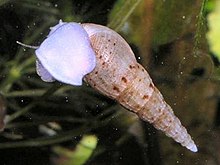Thiaridae
| Thiaridae Temporal range:
| |
|---|---|

| |
| A live individual of Red-rimmed melania, Melanoides tuberculata, crawling on the glass of an aquarium | |
| Scientific classification | |
| Domain: | Eukaryota |
| Kingdom: | Animalia |
| Phylum: | Mollusca |
| Class: | Gastropoda |
| Subclass: | Caenogastropoda |
| Superfamily: | Cerithioidea |
| Family: | Thiaridae Gill, 1871 (1823) |
| Synonyms | |
Thiaridae, common name thiarids or trumpet snails, is a
Taxonomy
Many species of freshwater snails that are characterized by a turreted shell were originally placed within the genus Melania Lamarck, 1799. This genus as delimited by authors of the late 19th and early 20th century contained hundreds of species, and was successively split into different groupings.[8] Over time, infrageneric groups (subgenera) were elevated to the rank of independent genera and the genus Melania was elevated to the rank of a family, Melanidae.[9]
However, the genus name Melania Lamarck, 1799 was demonstrated to be a junior synonym of the genus name Thiara Röding, 1798. Consequently, the family had to be renamed Thiaridae. Moreover, the Melanidae as traditionally circumscribed were found to be
Distribution
This family of snails is found worldwide, and are particularly diverse in the tropics and subtropics.[1]
Ecology
These snails are freshwater inhabitants of temperate and warm zones.[1]
Thiaridae are partly
Genera
Genera in the family Thiaridae include:
- Subfamily Thiarinae Gill, 1871 (1823)
- Balanocochlis Fischer, 1885 [1]
- Culenmelania Z.-X. Qian, J. Yang, Y. Lu & J. He, 2012
- † Kumania Ota, 1960
- Melanoides Olivier, 1804[2][11]
- Mieniplotia Low & Tan, 2014
- Neoradina Brandt, 1974
- † Pachymelania E. A. Smith, 1893:[11] synonym of † Pachychiloides Wenz, 1939 (junior homonym of Pachymelania E. A. Smith, 1893; Pachychiloides Wenz, 1939 is a replacement name)
- Plotia Röding, 1798: synonym of Pyramidella Lamarck, 1799
- Plotiopsis Brot, 1874[12] - Plotiopsis balonnensis (Conrad, 1850)
- Ripalania Iredale, 1943
- Sermyla Adams, 1854[2]
- Stenomelania Fischer, 1885 [2]
- Tarebia H. Adams & A. Adams, 1854[2]
- Thiara Röding, 1798 - type genus of the family Thiaridae,[11]synonym: Melania Lamarck, 1799
- Not assigned to a subfamily
- † Brotiopsis K. Suzuki, 1943
- † Coptostylus F. Sandberger, 1872
- † Cornetia Munier-Chalmas in Fischer et al., 1885
- † Ellinoria Van Damme & Pickford, 2003
- Fijidoma Morrison, 1952
- † Hannatoma Olsson, 1931
- † Heynderycxia Van Damme & Pickford, 2003
- † Juramelanatria Bandel, 1991
- † Juramelanoides Bandel, 1991
- Longiverena Pilsbry & Olsson, 1935
- † Melabrina Stache, 1880
- † Melanotarebia Bandel & Kowalke, 1997[2]
- † Pseudopyrgula Wenz, 1928
- † Ptychomelania Sacco, 1895
- † Sengoeria Harzhauser, Mandic, Büyükmeriç, Neubauer, Kadolsky & Landau, 2016
- † Sinomelania Yen, 1936
- † Siragimelania Suzuki, 1940
- † Tianjinospira Youluo, 1978
- Verena H. Adams & A. Adams, 1854
- † Yoshimonia Ota, 1960
References
This article incorporates public domain text from the reference[1]
- ^ a b c d e "Family summary for Thiaridae". AnimalBase, last modified 5 September 2006, accessed 14 April 2011.
- ^ a b c d e Bandel K. & Kowalke T. (1997). "Eocene Melanotarebia n.g. and its relation among modern Thiaridae (Caenogastropoda: Cerithioidea)". N. Jb. Geol. Paläont. Mh., Stuttgart 11: 683-695, 10 figs. abstract Archived 2011-07-26 at the Wayback Machine.
- .
- .
- ^ Children (1823). Quarterly Journal of Science, Literature & Arts 15: 243.
- ^ Ihering (1909). Journal de Conchlyliologie 57(4): 296.
- ^ MolluscaBase eds. (2021). MolluscaBase. Thiaridae Gill, 1871 (1823). Accessed through: World Register of Marine Species at: http://www.marinespecies.org/aphia.php?p=taxdetails&id=196287 on 2021-07-28
- ^ Brot A. (1874-79). Die Melaniaceen (Melanidae) in Abbildungen nach der Natur mit Beschreibungen. Nürnberg, Bauer & Raspe.
- ^ Thiele J. (1929). Teil 1. Loricata; Gastropoda: Prosobranchia. Handbuch der Systematischen Weichtierkunde. Jena, Gustav Fischer Verlag. 1: 1-376.
- ^ a b Glaubrecht M. (1996). Evolutionsökologie und Systematik am Beispiel von Süß- und Brackwasserschnecken (Mollusca: Caenogastropoda: Cerithioidea): Ontogenese-Strategien, paläontologische Befunde und historische Zoogeographie. Leiden, Backhuys.
- ^ ISSN 0076-2997.
- ^ Bouchet, P. (2016). Plotiopsis Brot, 1874. In: MolluscaBase (2017). Accessed through: World Register of Marine Species at http://marinespecies.org/aphia.php?p=taxdetails&id=818487 on 2017-11-20
Further reading
- Glaubrecht M., Brinkmann N. & Pöppe J. (2009). "Diversity and disparity down under: Systematics, biogeography and reproductive modes of the marsupial freshwater Thiaridae (Caenogastropoda, Cerithioidea) in Australia".
External links
 Media related to Thiaridae at Wikimedia Commons
Media related to Thiaridae at Wikimedia Commons
